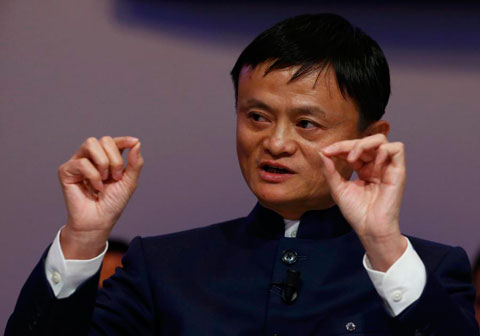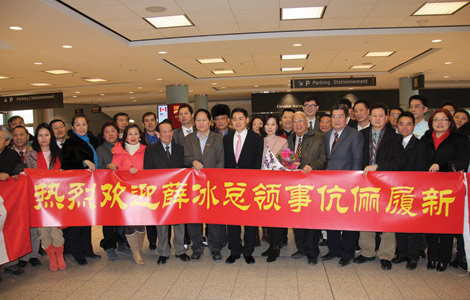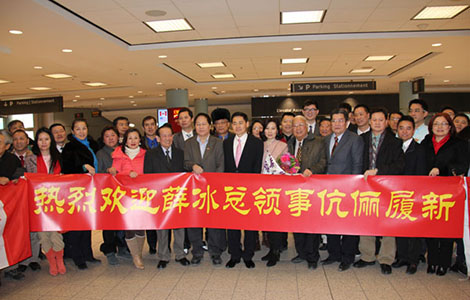Chinese brands derive rising revenue proportion overseas
Updated: 2015-01-30 04:59
By Zheng Xin in Beijing(China Daily USA)
|
||||||||
Chinese brands are deriving increasing revenue proportion overseas, according to the newly released 2015 BrandZ™ Top 100 Most Valuable Chinese Brands.
"With the Chinese companies further expanding their operation abroad and a more positive perception of Brand China to help facilitate the overseas acceptance of Chinese companies, not just as hot stocks, but also as consumer brands, the Chinese brands are deriving increasing overseas earning," said Doreen Wang, Global Head of BrandZ, Millward Brown.
The Chinese companies have witnessed steady increase of revenue gained abroad in recent years, and the trend is believed to continue, she said.
According to the newly released brand value ranking, Tencent becomes the most valuable Chinese brand for the first time, and newly-listed online retailer Alibaba entering the ranking at No.2.
Both brands leapfrogged long-time leader China Mobile, which had held the top spot since the ranking launched in 2011.
Chirantan Ray, deputy managing director at Millward Brown, said two leading Chinese technology brands already gain a significant portion of their revenue overseas, with Lenovo, the world's leading PC maker, driving 62 percent of annual revenue from overseas business, while global business drives 53.3 percent of revenue for ZTE, a maker of telecommunications equipment and systems.
Air China, with 34 percent revenue from international business, Petro China of 33 percent, TCL, which gains one third of revenue from overseas, and China Eastern Airlines with 33 percent international revenue, are also among those Chinese brands seeing most revenue from international business, said the report.
Ray said that airlines and oil and gas companies have also derived a lot of revenue from outside of China, and so do those home appliance brands, both as manufacturers for other brands and from their own branded businesses.
Ray also mentioned that the brands with the highest proportion of revenue from overseas are State Owned Enterprises
"Both Strategic SOEs, such as banks that help advance government policies, and Competitive SOEs in consumer-facing categories like food and dairy," he said.
However, Ray said the market-driven brands are building global business more rapidly, a development that resonates with Alibaba's stock market success.
"Of the 20 Chinese brands that lead in the proportion of revenue derived from overseas, half are market driven," he said.
"That's up from five market driven brands only a year ago."
E-commerce giant Alibaba is among the new brands. But the market-driven brands operate in diverse categories, including: cars, home appliances, real estate, retail and technology, said Ray.
BrandZ is the world's largest brand equity database conducted by Millward Brown, the world's second largest market research organization based in New York.
Millward Brown began the project five years ago with a ranking of the Top 50 most valuable Chinese Brands, and expanded to 100 brands last year to more fully examine the rapid emergence of China's valuable brands across 21 categories of products and services.
Ray said that the 2015 ranking also illustrates a rapid rise in the brand value of technology and tech-related retail brands.
Technology companies have become brand powerhouses, and as a result the technology category has now surpassed financial institutions as the highest value category, with $106.9 billion, contributing 23% of the Top 100's total value, according to the report.
Ray said he was confident that there are good chances that the transition of the Chinese brands will mirror how consumer worldwide perceive products made in Japan or South Korea changed over time.
The global expansion of Chinese brands depends on the determination of Chinese brands to shift from being manufacturers for western brands to being marketers of their own brands, said Ray.
The expansion also depends on changing international consumer perception of Brand China, so that the country long associated with low-price merchandise is viewed as a source for reliable, value-added products and services.
This transition would mirror how consumer perceptions of the products made in Japan or made in South Korea changed over time.
His voice is echoed by Doreen Wang, Global Head of BrandZ, Millward Brown.
"With China, the trajectory of change may be sharper, as illustrated not only by the explosive growth of Alibaba, but also by how a Chinese brand like Xiaomi, a maker of low price smart phones, can suddenly challenge South Korea's Samsung for market share in China," she said.
According to the report, during China's rapid economic rise over the past 30 years, Western consumers viewed Chinese brands as the makers of low quality products or products of adequate quality marketed by western companies under their own brand names.
That perception should change as China's economy rebalances and Chinese brands leverage their decades of production experience to make and market quality, value added merchandise under their own brand names, it said.
"To succeed abroad, Chinese brands need to bridge the gap between how consumers abroad perceive them and how they perceive successful global brands," said Wang.
"Alibaba's record IPO is believed to help improve the consumer view of Chinese brands, but changing long-held perceptions takes time."
Wang said the change should start with the understanding of the perception gap, and the ranking 2015 reveals that the distinctiveness of Chinese brands could be based on greater approachability and empathy compared with their more distant and autocratic global competitors.
As Chinese brands go global, they'll need to leverage points of difference to stand out from the competition, said Wang.
According to the recent BrandZ research about international travel, people who travel outside their own country score China relatively high in being different as a destination, and this idea of a difference attracts traveler and is at the heart of potential tourism growth.
"The appeal of difference also applies to brands," said Wang.
Wang also expressed her concerns with the exponential growth of the Chinese brands on the international stage, such as the United States.
"For many Chinese companies, despite their rapid growth, maintaining that exponential growth abroad has proven a great challenge," she said.
"The Chinese brand recognition in US still pretty low, and to further crack the local-to-global code in pursuit of the brand dominance on a global stage, it is necessary the Chinese companies further invest and build up their brand value."
Millward Brown's 2013 Going Global Awareness Study suggests the awareness of Chinese brands is lowest in the US, with only six percent of US consumers who can name a Chinese brand.
In the US the reputation of Chinese brands is usually associated with government-run companies, safety issues and fake merchandise, said the 2014 BrandZ Top 100.
"Instead of maintaining keen to achieve quick success and instant benefits, the Chinese companies should attach more focus on the investment in the brands and benefits in the long term."
"Many would neglect the significance of bringing more purpose-based societal benefits to its consumers," she said.
That being said, the overall Chinese brand value has still also significantly increased, with its growth sharply shifted from the SOEs (state owned enterprises) to market driven brands, according to the report.
The market-driven Chinese brands almost doubled in value year-on-year, while the value of the SOEs, despite still significant contributors to the ranking and key roles in China's broader economy, declined nine percent, said the report.
According to Wang, the market drive brands now comprises 47 percent of the total value of the BrandZ China Top 100, up from 29 percent in 2014.
"Consumers worldwide have increasingly accepted Chinese brands more than ever, because they see them as meaningful and dynamic, not only because they're well-known," said Wang.
zhengxin@chinadaily.com.cn

 Ten surprising facts about Jack Ma
Ten surprising facts about Jack Ma
 Gas blast at Mexico City children's hospital kills 7, injures 54
Gas blast at Mexico City children's hospital kills 7, injures 54
 Ten characteristic streets in Beijing
Ten characteristic streets in Beijing
 Outgoing US Defense Secretary Hagel lauded at farewell
Outgoing US Defense Secretary Hagel lauded at farewell
 Don't have to be a queen to live in frozen wild of snow
Don't have to be a queen to live in frozen wild of snow
 Across Canada Jan 30
Across Canada Jan 30
 New consul general greeted
New consul general greeted
 Gateway to Houston
Gateway to Houston
Most Viewed
Editor's Picks

|

|

|

|

|

|
Today's Top News
Mongolian culture to highlight New Year's concert
Alibaba quarterly revenue disappoints, shares fall
'Nightmare' incompatible with China-US relations
Alibaba adjusted profit tops estimates, revenue falls short
US ambassador to China calls for Flying Tigers movie
Taobao locks horns with regulator
China to expand Shanghai FTZ policies nationwide
China's train makers to court investors on road show
US Weekly

|

|








